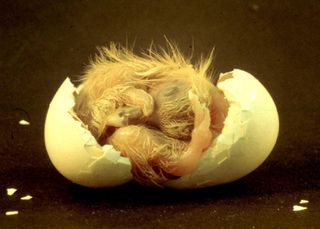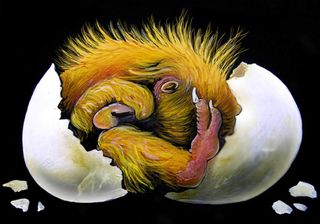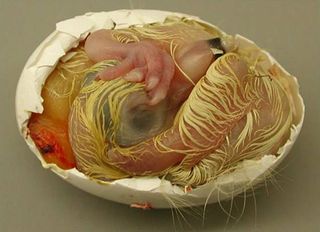Pirate-Eye Pigeons Reveal How the Brain Talks to Itself

As a baby bird develops, its body contorts to fit within the confines of its egg. The bird's neck twists so that one side of its head is tucked against its chest. In this position, the bird's left eye remains nestled among sprouting feathers—where it does not receive much light from the outside world—whereas the right eye is pressed up against the eggshell, glimpsing flickers of light and shadow through a veil of calcium carbonate. Even though this uneven stimulation of the eyes lasts only one or two days before the chick hatches, it seems to be crucial for typical brain development. Pigeons incubated in the dark have a much harder time solving puzzles as adults than pigeons exposed to light before hatching. The reason, some researchers think, is that the brain's two hemispheres cannot properly integrate information if they miss a critical window period of learning in the egg.

Martina Manns of Ruhr University Bochum in Germany has been studying pigeon brains for the past 20 years. For a new study published in the February issue of Nature Communications, Manns and her colleague Juliane Römling focused on 14 domestic pigeons raised in normal lighting conditions by local breeders and another eight pigeons raised in dark incubators in their lab. (Scientific American is part of Nature Publishing Group.)
Through various memory tests and logic puzzles, Manns and Römling compared the problem-solving abilities of the two groups of birds. One by one, Manns and Römling presented each pigeon with different pairs of plastic cups filled with colorful aquarium gravel, only one of which concealed a kernel of corn. There were four pairings: red and blue, blue/green, green/yellow and yellow/violet. Through trial and error the pigeons learned to prefer one color in each pair, because gravel of that color always contained the tasty snack. Given a choice between blue and green gravel, for instance, blue was always the right answer; green gravel always contained the reward when matched with yellow, etcetera.After enough trials, the conventionally raised pigeons inferred a hierarchy of the most fruitful colors: red > blue > green > yellow > violet.
For instance, blue was always the right choice, unless it was paired with red. Violet was never the correct answer. Using this inferred knowledge, the light-exposed pigeons knew which cup of gravel contained the corn even when presented with color pairs they had never seen before, such as blue and yellow. In contrast, the pigeons raised in the dark never figured out the hierarchy and failed to make the right choice when faced with novel color pairs.
Here's the twist: during all these tests, the pigeons wore eye patches over one eye, so that the birds learned to discriminate some pairs with their left eye and others with their right. Because the left eye primarily communicates with the right brain hemisphere, and the right eye primarily communicates with the left brain hemisphere in birds, the two hemispheres were preoccupied with different sets of visual information. (The bird visual system, in which the optic nerves cross completely, differs from the human visual system, in which each eye sends information to both brain hemispheres.) Even though birds lack a corpus callosum—the thick band of neural tissue linking the mammalian brain's two hemispheres—earlier research has established that the two halves of the bird brain exchange information via different cellular bridges.

In the new study, all the pigeons correctly discriminated familiar color pairs with either eye, regardless of which eye was covered during their learning trials—clearly one brain hemisphere could transfer information to the other. But when pigeons raised in the dark encountered a completely novel pair, such as blue and yellow, they were stumped: even with both eyes open, they did not know which color to choose. That's because, Mann thinks, only pigeons raised in light could solve a problem that required knowledge from both brain hemispheres simultaneously. One hemisphere had learned that blue was a better choice than green; the other had learned that green was a better choice than yellow. Realizing that blue was therefore a better choice than yellow demanded communication between the two hemispheres that pigeons raised in the dark could not muster.
"The tests used are rather difficult to follow," admits Lesley Rogers of the University of New England in Australia, who has extensively studied the structure and function of bird brains but was not involved in the new study, "but the study does show that interhemispheric communication depends on exposure to light before hatching, and hence on asymmetry of visual processing." In her own work, Rogers discovered that only two hours of uneven light stimulation one or two days before hatching triggered structural and functional asymmetry in a chick's brain. Although both halves of the bird brain process visual information, Rogers, Mann and a few others have shown that each hemisphere is particularly good at certain tasks: the left hemisphere is better at discrimination tasks and noticing fine details, whereas the right hemisphere seems to direct overall visual attention. It is possible that in Mann's new study, the pigeons raised in the dark could not combine the distinct talents of the right and left hemispheres to solve a visual problem they had never seen before.
Sign up for the Live Science daily newsletter now
Get the world’s most fascinating discoveries delivered straight to your inbox.
The idea that cognitive talents are divided between the two halves of the brain in people, other mammals, birds and some other vertebrates remains somewhat controversial. Neuroscience studies have made it abundantly clear that there is no such thing as a "right brain person" or "left brain person"—the human brain is remarkably symmetrical. In many cases, both hemispheres contribute to the same cognitive ability. And, if one hemisphere is damaged, the other can pick up the slack. But there is also a lot of evidence suggesting that even if both hemispheres contribute equally to a cognitive task such as speech or creating a visual model of the world, each half may favor particular aspects of that task. For her part, Mann hopes to untangle these issues. And she thinks there is no better model than bird brains.
This article was first published on Scientific American. © 2012 ScientificAmerican.com. All rights reserved. Follow Scientific American on Twitter @SciAm and @SciamBlogs. Visit ScientificAmerican.com for the latest in science, health and technology news.
Most Popular


